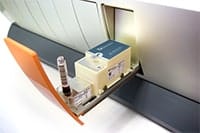Home » Clinicians » Hospital Pharmacy
Hospital pharmacists serve a critical leadership role in fighting antimicrobial resistance. They can reduce the administration of empiric therapy when it is not necessary while ensuring the patients suspected of sepsis receive targeted treatment as soon as possible. Current data estimates the U.S. death count in 2010 from multidrug-resistant organisms (MDROs) was between 153,113 and 162,044.1 These estimates are more than 6 times higher than previous CDC estimates, placing MDROs as the third leading cause of death in the United States.2
Dangers of delaying treatment: Delays in test results based on blood-culture-dependent methods put hospital pharmacists and stewardship committee members at a major disadvantage. Their only choice is to use empiric therapy for all patients suspected of sepsis. This results in:
Faster, targeted therapy: Using T2Direct Diagnostics™, hospital pharmacists can determine accurate species identification in 3 to 5 hours and quickly recommend the most appropriate treatment.
The T2Bacteria® and T2Candida® Panels have demonstrated high specificity (>98%) in independent studies covering over 3,000 patients in more than 15 institutions.3,4 They can detect the most prevalent and common ESKAPE pathogens, enabling faster-targeted therapy for patients with bloodstream infections. And with exceptionally high negative predictive values (NPV) throughout a hospital – typically 98- 99% or more – the Panels have proven to provide stewardship teams with the confidence to safely de-escalate empiric therapy and spare negative side effects for patients.
Investigators from Lee Health demonstrated detection of all organisms identified by blood culture and significant de-escalation opportunities due to a negative S. aureus or negative P. aeruginosa results.10
*Henry Ford Health System demonstrated patients tested with the T2Candida Panel were treated in a median of 5 hours – more than an eightfold improvement compared to blood culture.11 Similarly, Lee Health found the time to initiation of appropriate antifungal therapy was only 6 hours from the time of blood draw in the T2Candida-positive patients.5 T2Direct Diagnostics tools can help de-escalate therapy, leading to pharmacy savings and reduced nephrotoxic side effects on patients. Hospitals, including Lee Health, Huntsville Hospital, and University of Pittsburgh Medical Center, have reported antifungal savings that more than covered the full cost of testing at their institutions, with as much as a 2.1 day reduction of micafungin therapy per patient.5,7,8
Contact us to request a demo of T2Direct Diagnostics!
……………………………………….
1. Burnham JP, et al. Infection Control & Hospital Epidemiology, 2018
2. Stewardship/Resistance Scan for Nov 26, 2018. CIDRAP, 2018
3. Mylonakis E, et al. Clinical Infectious Diseases, 2015
4. Nguyen, M. H., et al. Performance of the T2Bacteria Panel for Diagnosing Bloodstream Infections. A Diagnostic Accuracy Study. Annals of Internal Medicine. 2019.
5. Patch ME, et al. Journal of Antimicrobial Chemotherapy, 2018
6. Kateon H, et al. IDWeek 2016
7. Edwards JD. Poster Presentation, ASM Microbe, 2017
8. Shields R, et al. Poster Presentation, IDWeek, 2018
9. Kirn T. Oral Presentation, ASM Microbe 2017
10. Weisz E, et al. Poster Presentation, MAD-ID 2018
11. Wilson NM, et al. The Journal of Antimicrobial Stewardship, 2017
12. Centers for Disease Control and Prevention, 2016

Sensitivity: 90%7
Specificity: 98%7
E. faecium
S. aureus
K. pneumoniae
A. baumannii
P. aeruginosa
E. coli
T2 Biosystems, an emerging leader in the field of in vitro diagnostics, is dedicated to saving lives and reducing the cost of healthcare by empowering clinicians to effectively treat patients faster than ever before. T2 Biosystems is focused on addressing critical unmet needs in healthcare starting with sepsis, one of the deadliest and most expensive conditions in hospitals today.
The T2Dx Instrument, the T2Bacteria and T2Candida Panels have received marketing authorization from the U.S. Food and Drug Administration. All other T2 Biosystems products are considered investigational and for research use only.
T2 Biosystems®, T2MR®, T2Bacteria®, T2Candida®, T2Resistance® and T2Dx® are registered trademarks of T2 Biosystems, Inc. “T2Biosystems” and the T2 Biosystems, Inc. logo design are registered trademarks or trademarks of T2Biosystems, Inc. All software and documentation is subject to T2 Biosystems, Inc. copyrights. All rights reserved. T2Direct Diagnostics™, T2HemoStat™, T2Plex™, T2Cauris™, T2Lyme™ and T2SARS-CoV-2™ are trademarks of T2 Biosystems, Inc.
© 2024 T2 Biosystems, Inc.
Please tell us where you are visiting from: United States | Outside the United States